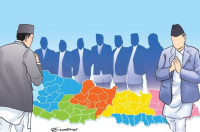Opinion
Something’s wrong here
Dalits receive their old age allowance at 60 while others have to wait until they are 70
Sony KC
An old age allowance is a visible marker of a functioning state, demonstrating particularly the acknowledgement of thousands of senior citizens. In Nepal, this universal scheme bolsters the elderly population with the reinforcement of a monthly unconditional cash transfer of Rs 500. Previous studies and media reports have highlighted the benefits of such support in line with covering food and health needs, reinforcing family income, strengthening familial ties through sharing and maintaining social cohesion between elderly beneficiaries within the community. Studies have also emphasised the constraints people face regarding geographical location, untimely distribution of allowance, acts of fraud by officials through the use of fake names and leakage of funds. However, one interesting issue that has not yet been brought into debate is the targeting mechanism and its social effects within the community.
Ethnic barrier
The Nepal Centre for Contemporary Research, through its Secure Livelihoods Research Consortium project, recently conducted a qualitative field survey in Budagaon VDC and Liwang, headquarters of Rolpa, on the issue of old age pensions to examine the people’s perception of the state. This research was conducted in line with quantitative data gathered from a longitudinal survey carried out in 2012. The findings, though not limited to just this, demonstrated a form of ethnic clash between Dalits who are eligible to receive the pension at the age of 60 and other ethnic groups who have to wait until they are 70. On the one hand, the allowance is
a universal social protection mechanism while on the other, it reinforces one ethnic group over others.
Beneficiaries belonging to ethnic groups other than Dalits, particularly from the poorer households, frequently expressed their discontent at the age-ethnicity barrier and their income status. An elderly Brahmin man said rancorously, “It is not appropriate to draw a line based on ethnicity and age. I survive on the allowance, which is my only income source. My neighbour, whose son sends remittance home, got it when she was 60 while I had to wait till I turned 70. The state needs to be thoughtful.”
We need no evidence to prove that there are people from other ethnicities who are poorer than Dalits. A 73-year-old Janajati woman lamented, “I recently lost my son. He suffered from an illness for eight years.
I spent all my money and sold my land and everything else for his treatment. I am still paying the debt from my old age allowance. Had I received it when I was 60, I could have saved my son and my property.” A few elderly men and women with better economic status said that the state should provide money based on how poor the households are rather than on the current criteria.
Just good fortune?
The age-ethnicity barrier has created difficulties for elderly Dalits who are interrogated and even subjected to taunts such as “It is your rule now” and “You age earlier than us, what can we say?” These people usually have no answers to explain why they are receiving payments earlier than others and simply guess that it is their good fortune. One Dalit beneficiary, an ex-Indian Army soldier, explained, “I get a lot more money from the Indian government for my service than the old age allowance. And it is unfair to have an age barrier on the allowance. The government says that there is no discrimination based on caste or creed anymore but they still follow it. I have friends from other ethnic groups who live alone and have no income. This system should be taken down.”
None of the Dalit respondents, as other ethnic groups, interviewed showed a sense of satisfaction with the current pension distribution by age. These groups of people showed feelings of hesitation and awkwardness. They expected the state would raise the money and provide it to all the elderly people of different ethnic groups at the same age.
Targeting this universal cash transfer has indeed created direct or indirect social tensions among communities in Rolpa. However, the bitter truth lies in our history of caste hierarchy, which puts Dalits at the bottom of the ladder, thus depriving them of policies and other rights. Paradigm shifts, transitions and new policies have helped to abolish the practice of untouchability over the decades, particularly after the insurgency.
The state came forward strongly for Dalit communities by enacting policies aimed at lifting their status to one free from ostracism and discrimination. In the form of safety nets for these groups, the government runs scholarship programmes to benefit Dalit children and their communities. And this is where the old age allowance became effective in giving leverage to Dalits and marginalised groups while reinforcing social division. On the one hand, it attempts to redress historical marginalisation while on the other, it draws a thick line due to the age restriction between senior citizens. In some ways, it also brings back history.
Reconsidering age-ethnicity
What is difficult to understand is the drawing of a line between ethnic groups and putting forward age as a barrier. The caveat here, with regard to policy framing, is not that Dalits should not be compensated for what they have been through but that age should not be a barrier, especially when it comes to supporting elderly groups.
It might be taken as providing polio vaccination to Dalit children at a certain age and to children of other ethnic groups at a different age.
Putting elderly people of different groups in the dichotomy of age-ethnicity might create turmoil and generate more hatred towards each other. Evidence already reflects the mushrooming of negative consequences due to the age barrier between Dalit recipients and recipients of other ethnic groups. Setting targets based on people’s income and poverty has worked well in most situations but targets based on age could give rise to negative state-people relations, like with the old age pension. It might be crucial for social protection policymakers to reconsider the age-ethnicity barrier and not place one group of elderly people over another. The state is admired for the scheme and its success in representing elderly people but it has also attracted criticism for turning back the wheels of discrimination due to its ethnic bias.
KC is a research officer at the Nepal Centre for Contemporary Research on Livelihoods, Basic Services and Social Protection




 17.12°C Kathmandu
17.12°C Kathmandu










